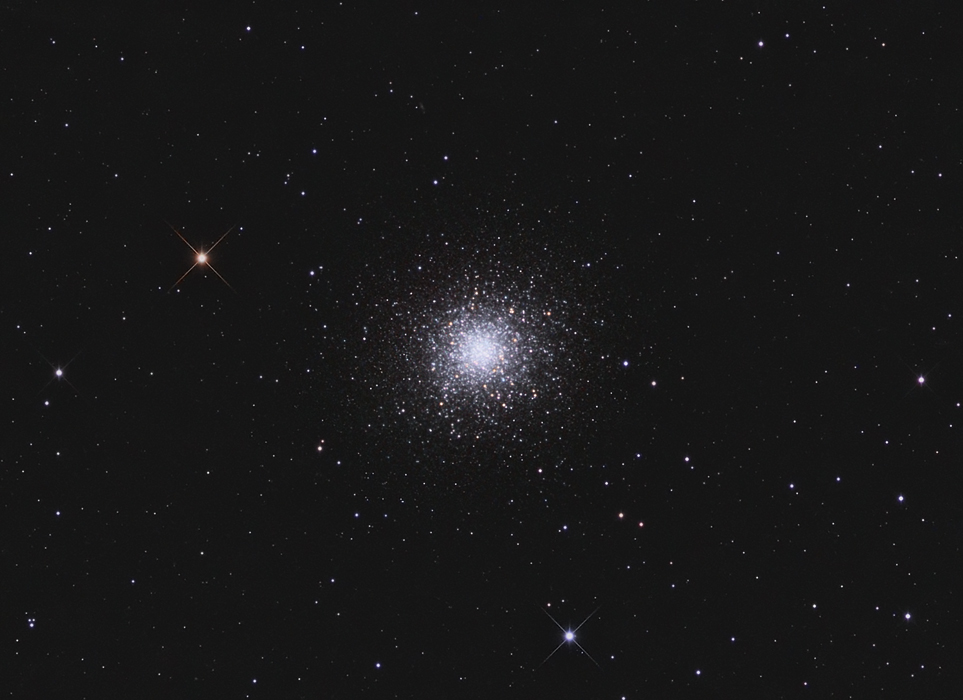The Great Globular Cluster in Hercules (M13, NGC 6205)
Characteristics:
Magnitude: 7.0
Size: 0.36 degrees
Distance: 25,000 light years
RA: 16h 41m 38s
Dec: 36 degrees 28' 03"
Description:
No one forgets their first view of M13 in the eyepiece. It's a
remarkable site, with speckled stars arising from the center giving it
an almost 3-dimensional appearance. This globular cluster is 25,000
light years away,
orbiting near the center of our galaxy. Globular clusters contain
stars at such high density that the night sky would be filled
with light, and planetary orbits would be unstable due to gravitational
influences
from nearby stars. The stars of M13 are very old and
consequently
contain very little metal (they were formed at a time when basic
elements
like iron had not yet been forged by other stars). So it is
unlikely
that earthlike planets formed around any of the stars in this cluster.
The
message sent to M13 by the Arecibo Radio
Telescope team in 1974 will most likely fall on deaf ears.
Most of the stars contained within M13 are no longer burning hydrogen
to helium in their core. These stars have left the main
sequence and are engaged in either burning hydrogen to helium in
their outer shell (red giant and supergiant phase) or burning helium to
carbon in their core (horizontal branch phase). The Hertzsprung-Russell
diagram for the globular cluster M5 is similar to what might be
seen for M13 (from www.SEDS.org). I have color-labeled a
few regions of this diagram here (I
suggest opening this in a separate window while reading the notes
below). A few things are interesting to note:
1. There is an obvious turn off point (shown in red), which
indicates that most of the hot, large, blue stars have already left the
main sequence and have gone down the path of red giants and supergiants
(tan region). Their core hydrogen has been exhausted, and they
are now burning hydrogen to helium in their shell, causing expansion
(more luminous) and cooling (shifting to the upper red region of the HR
diagram). A prominent turn off point in the HR diagram is
characteristic of very old globular clusters, whereas young open star
clusters generally show a predominent main
sequence population.
2. Once a red giant/supergiant exhausts hydrogen in its shell,
fusion of helium to carbon begins in the core (helium flash, point
C). The renewed fusion increases the stellar temperature,
shifting it into the blue, Horizontal Branch region of the HR diagram
(point D).
3. Note the gap in the Horizontal Branch region (point E).
This is populated by RR
Lyrae
variables, which are also burning helium to carbon in their
cores. RR Lyrae stars are variables whose brightness changes in a
predictable way over a given period. Because they are unstable,
they do not remain at a given point on the HR diagram, hence creating a
gap in the Horizontal Branch. The period-luminosity relationship
of RR Lyrae stars can be used to determine absolute magnitude
(magnitude at 10 parsecs), which can then be compared to apparent
magnitude in order to determine distance (similar to the technique
using Cepheid
Variables).
4. I've labeled a possible region for so-called "Blue Stragglers"
in yellow. Stars in this location are hot (blue) and still on the
main sequence, even though they should have entered the turn off point
a long time ago (hence the term Straggler). Why they are still
burning hydrogen to helium in their cores is not fully known- it is
thought that Blue Stragglers might be derived from collision with
another star within the crowded center of globular clusters, providing
a renewed source of hydrogen for fusion.
With this background, you can appreciate that most stars in my image of M13
are very old and have left the main sequence. The red stars are
giants or supergiants that are burning hydrogen to helium in their
outer shell. The blue stars most likely represent at least three
separate populations: Horizontal Branch stars, Blue
Stragglers, and RR Lyrae stars. Special
thanks to Rob Gendler, Al Kelly, Paul Howell and other colleagues on
the CCD mailing list for
contributing to a discussion of this interesting area.
Photographic
Details:
Date: July 3, 2005
Scope: Takahashi
FS102 at f8, on the G11 Losmandy
Mount.
Autoguider: SBIG STV with
e-finder.
Camera: Maxcam CM10.
Filter: Astronomik
RGB type II filter set.
Exposures: LRGB composite.
6 x 5' for luminance (unbinned); 3 x 5' each for R, G, and B binned 2 x
2. Two thin pieces of kite string attached to the dew shield with
tape were used to create the diffraction spikes.
Conditions: Temperature 65 degrees F; poor
transparency; average seeing; calm. Suboptimal conditions for imaging anything
other than a star cluster! High thin clouds covering the
region, causing bright stars like Vega to wink out. I set up
earlier and didn't want to waste the session, so I decided to shoot M13
before the meridian flip and then called it a night.
Post-processing: Calibrated
subs were debloomed with Ron Wodaski's Debloomer software, and then
aligned in Registar. Sigma combined using RC Sigma Reject
MaximDL, followed by DDP
in ImagesPlus (IP). Levels,
curves, high-pass sharpening in Photoshop CS (16
bit format).
Please
note: Graphics on this website may not be reproduced without
author permission.
Back to Star
Clusters
Home

